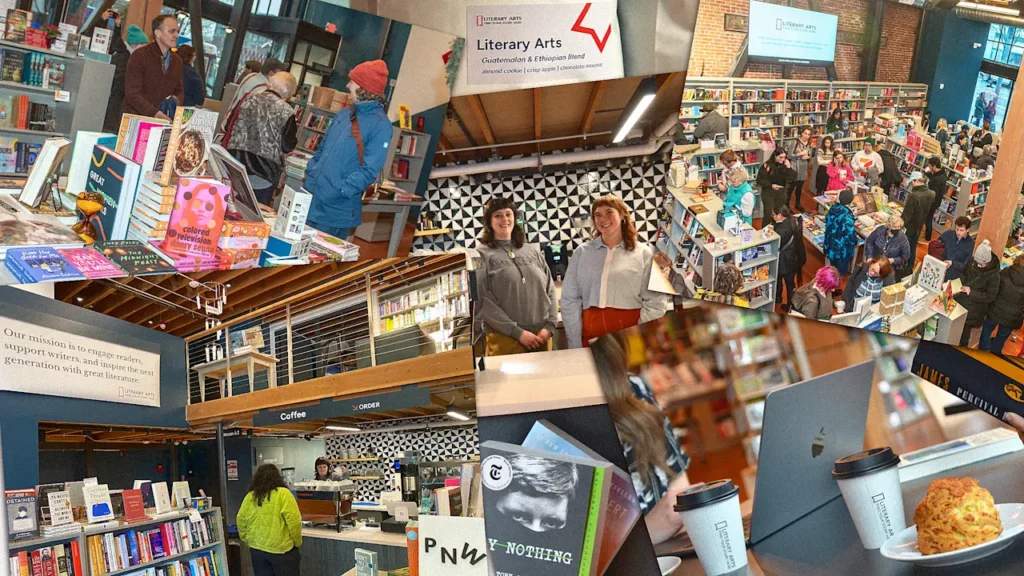
The bookstore cafe at Literary Arts’ new headquarters in Portland, Oregon was a hive of activity on a recent weekday morning. A few 20-somethings gathered for coffee in a corner, while at a nearby table, New Yorker cartoonist Tom Toro discussed his new book, And to Think we Started as a Book Club. . ., with a journalist. Meanwhile, Olivia Jones-Hall, Literary Arts’ director of youth programs, chatted with some colleagues about upcoming events.
Just a few days earlier, President Trump had announced on social media that he was ordering his ‘Secretary of War,’ Pete Hegseth, to send the national guard into “War ravaged Portland” to bring the city to heel—a directive aimed at the city’s largely peaceful anti-ICE protests and fueled by the president’s blatantly false assertion, which he expressed in September, that riots have engulfed Portland “every night.” (This assertion appeared to be based on a 5-year-old old clip on Fox News of the 2020 Black Lives Matter protests.) In reality, Portland is far from the “burning hell hole” of the President’s imagination.
Here in the Central Eastside Industrial District, five minutes from downtown and about 15 minutes from the ICE facility, the focus is on books not troops. And the solution to shoring up the public safety and economy in some of the city’s underinvested quarters is arts-driven community-building, care of Portland’s 41-year-old nonprofit Literary Arts, which is known for organizing the annual Portland Book Festival each November.
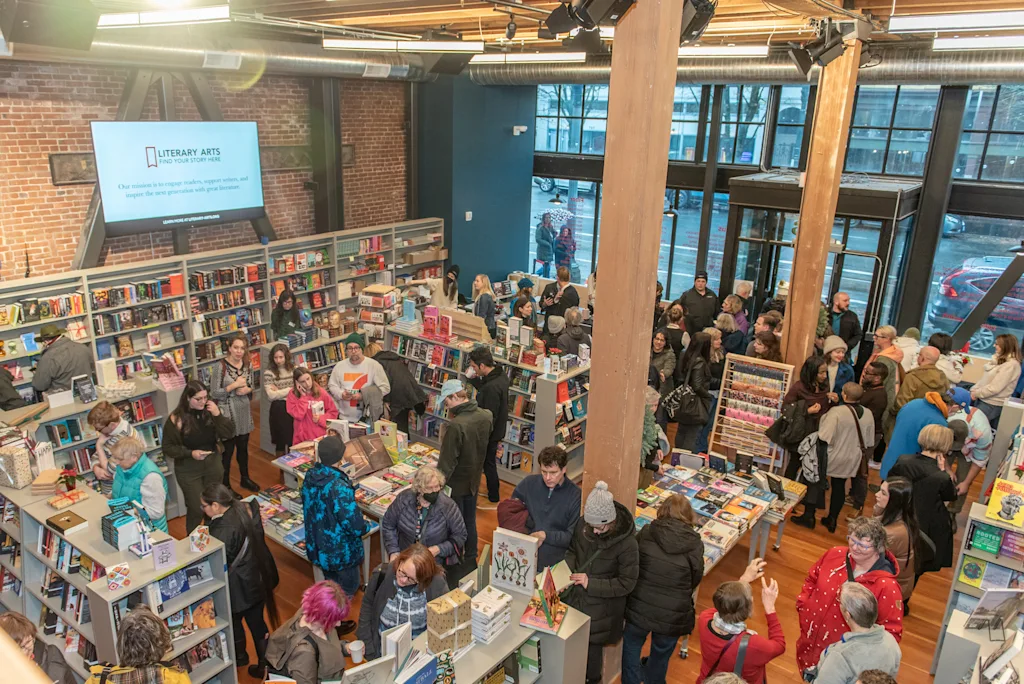
Indeed, since the organization announced, in 2022, its plan to move into a 14,000-square-foot former hardware store in the once-industrial Eastside neighborhood, the area around it has become a vibrant hub. Literary Arts’ new headquarters, which opened last December, include an independent bookstore and café, four classrooms, a podcasting studio, offices for the organization’s 32 staffers, and an event venue that can seat 75 people. The blocks around it, meanwhile, house restaurants, bars, stores, and a soon-to-open apartment building.
“Arts and cultural organizations have often been at the forefront of how we rebuild public space,” says Literary Arts executive director, Andrew Proctor. “So I think that one of the paths to recovery for the city is going to be through arts and culture.”
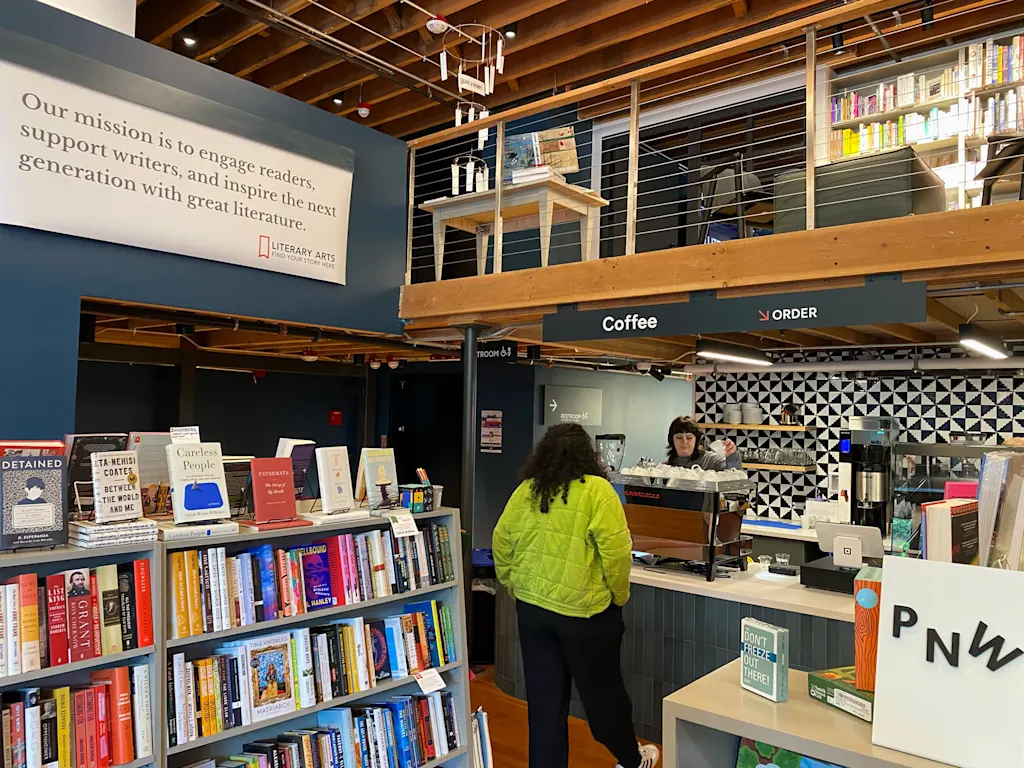
A literary giant
Literary Arts has had a big year. In addition to opening its headquarters, which it was able to purchase outright with a $3 million gift, the organization announced the successful completion of a fundraising campaign that raised more than $22.5 million in support of its community hub and the future Ursula K. Le Guin Writers Residency. (Located in the writer’s former house, the residency is slated to open in fall of 2027.)
It has also scored some major literary coups, securing visits from Timothy Snyder, Kamala Harris, and Stacey Abrams—all of whom will be appearing at the city’s 2,770-seat Arlene Schnitzer Concert Hall in the coming weeks. And lest you think Literary Arts attracts only serious nonfiction writers and politicians, “romantasy” author Rebecca Yarros will be speaking to a sold-out auditorium during the book festival on November 8. (And Stacey Abrams won’t be talking politics—she’ll be discussing her new thriller, Coded Justice.)
“In this moment, we are stuck in a very short cycle of thinking and reading, and that cycle is being dictated to us by technology,” says Proctor. “How long can you wander the desert of the internet before you realize you’re starved and parched and not getting nourished by this stuff? Like never!”
Proctor believes Literary Arts’ in-person events offer an alternative. “These books, these experiences with books, are very nourishing. And when you pair that by being out in community, it’s even more rich, because now you’re reading the same things or you’re at the festival standing in line talking to a stranger about something that you love and realizing that the world isn’t so strange and hostile.”
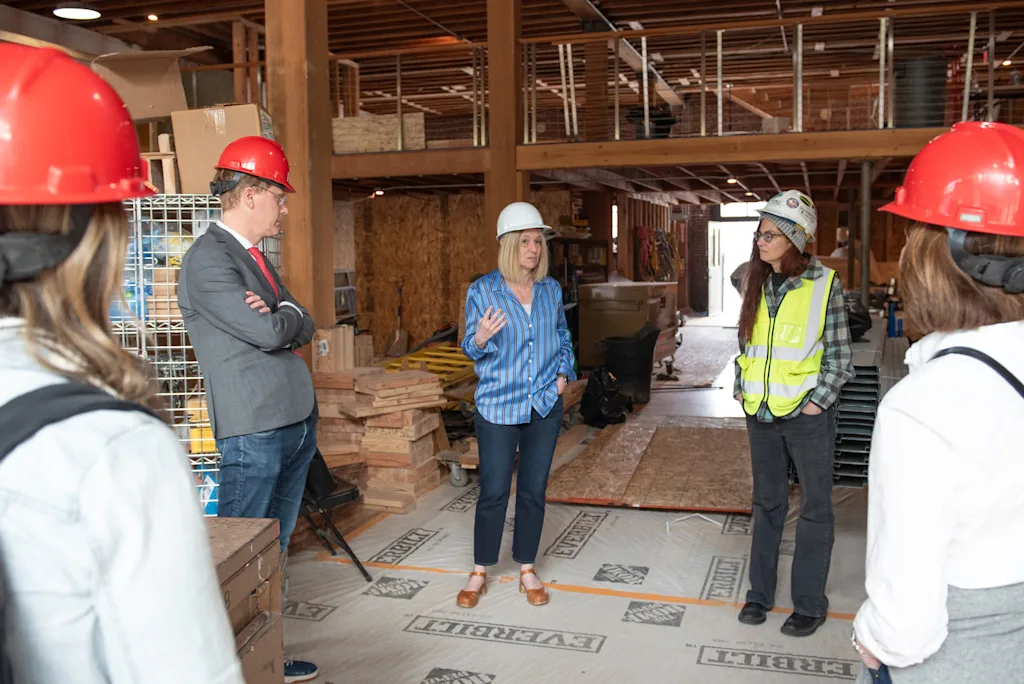
Literary Arts, which also runs the Oregon Book Awards, the youth poetry slam competition Verselandia!, Writers in the Schools residencies (which pairs working writers with local high schools), and Portland Arts & Lectures event series, took ownership of the Portland Book Festival in 2015. This year, tickets have been selling at 10 times the speed they did last year, says Proctor. He thinks that the need for deeper experiences—and maybe a little escapism—may be driving this engagement.
The festival is an easy sell to authors and publishers, says senior artistic director Amanda Bullock, because it tends to move books. That could be because the $18 ticket fee includes a $5 coupon towards any book sold at the festival. (Kids 17 and under get in for free.)
There will be more than 100 authors and interviewers at the festival this year, along with drop-in writing workshops and pop-up readings. Authors include big names like Abrams and Yarrows, but also plenty of new or up-and-coming authors. Roughly 40% of the presenters are from the Northwest.
In addition to the day-long series of readings and interviews downtown, there are dozens of other events that go on for a full week as venues around the city host literary or musical events.
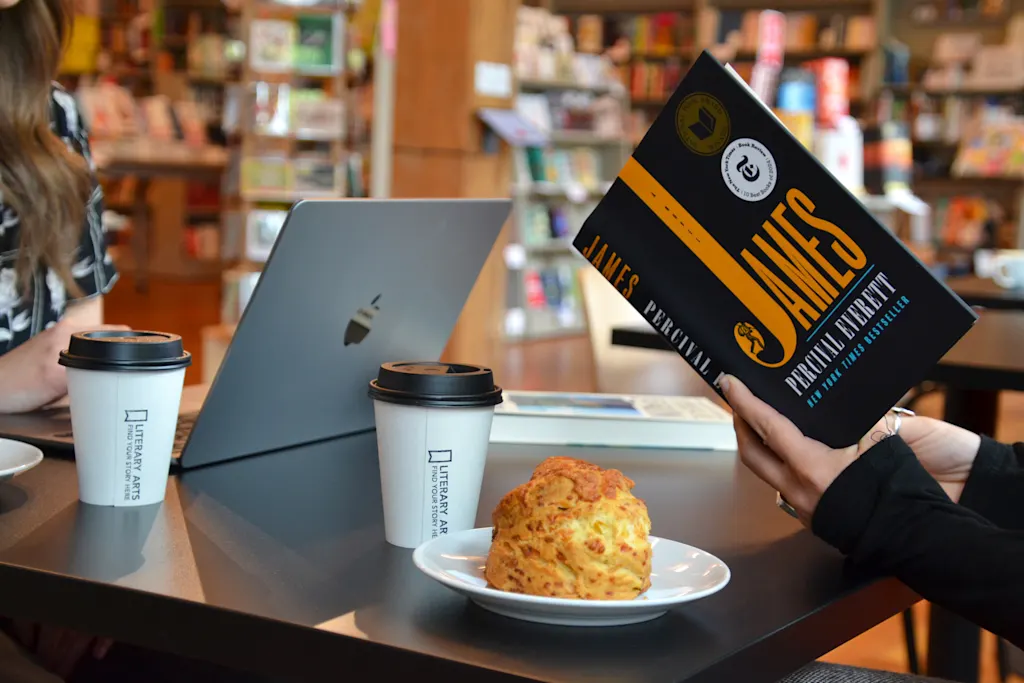
A Tale of Two Cities
Trump’s disparagement of Portland comes at a moment when the city is turning a corner. During the pandemic, Portland saw crime rates rise, alongside increased homelessness and open drug use. But today, homicides are down 41% compared to this same time last year, fewer people seem to be openly using illicit drugs (a result, no doubt, of state lawmakers recriminalizing illicit drugs in 2024), and Mayor Keith Wilson has been opening homeless shelters at a fast clip. The city is also preparing to welcome the planned $25 million James Beard Public Market, Portland’s answer to Seattle’s Pike Place Market, in downtown next summer.
Indeed, the President’s recent characterization of Portlanders as “living in hell” was so at odds with how locals experience their home that it promoted a rush of social media posts showing images of children running joyfully around fountains, crowded dog parks, and drool-worthy plates of food—all tagged #warravagedportland and #warravagedpdx. One Instagram threads user posted: “Danny here, reporting live from war-torn Portland. The smell of BBQ permeates. The puppies are viciously kind. People are doing yard work. This is not okay. Pray for us. #pdx.”
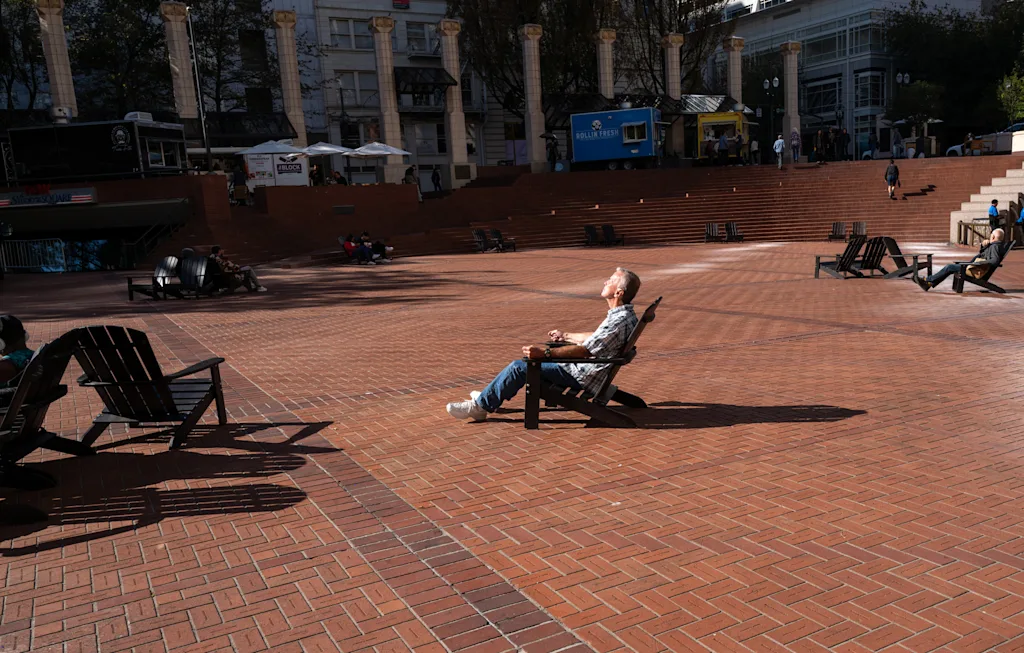
The truth is, the anti-ICE demonstrations have continued to be largely peaceful (at least on the side of the protesters), despite Trump calling up the Oregon National Guard and, after a federal judge barred him from doing so, the California and Texas National Guards. (The judge has since barred any National Guard from any state from being sent to Oregon.) Meanwhile, downtown Portland and the Central Eastside, both of which wrestled with homeless encampments and crime during the pandemic and in the years immediately after, are on the upswing.
Artists and arts organizations have long played a role in reviving derelict neighborhoods, including New York’s SoHo in the 1970s and Wynwood in Miami in the early aughts. Literary Arts, likewise, has played a key role in Portland.
The Portland Book Festival, which is based along the Park Blocks downtown, traditionally brings more than 6,000-plus book lovers to the city’s core. Readings, interviews, and workshops are held in the Portland Art Museum, a handful of different theaters, and at downtown churches.
Literary Arts also runs Portland Arts & Lectures, one of the largest literary lecture series on the west coast. On the evenings that big name authors come to town, downtown restaurants are booked up weeks in advance. “Arts & Lectures turns one of those [week] nights into a Saturday night,” says chef Greg Higgins of Higgins, which is two blocks from the Arlene Schnitzer Concert Hall.
The organization raised a few eyebrows when it selected as its new home Central Eastside, which sits along the Willamette River and was the city’s industrial and maritime hub in the late 1800s. The neighborhood, while gritty, managed to thrive even as trade dried up in the 20th century, and experienced something of a revival in the early aughts, as businesses moved into its once-industrial buildings. But it was hit particularly hard during the pandemic.
But over the past year, the area—particularly the block on Grand Avenue where Literary Arts is based—has been reinvigorated by multiple businesses and nonprofits. Across the street from Literary Arts is the Architectural Heritage Center, which has been infused with new energy and exhibits thanks to a dynamic new executive director; used bookshop Mother Foucault’s, which hosts readings and events every weekend, moved into the adjacent space. Next to Literary Arts is vegan Japanese restaurant Obon Shokudo where celebrities like Anya Taylor-Joy have been spotted. On the corner is Lollipop Shoppe, a lively bar and music venue.
“The building is open from 7 in the morning till 8 at night. Every day we’re serving coffee and food, and there are three events a week in the bookstore,” Proctor says. “It’d be hard to imagine us not having a pretty big impact on the neighborhood in a positive sense, just by sheer activity alone.”
Journalist and urban advocate Randy Gragg, who runs civic design nonprofit City of Possibility—where he organizes talks, exhibits, and gatherings about Portland design, architecture—and civic ambition, says he’s seen Literary Arts make an impact on Portland.
“They have really crystalized Portland as a literary center practically since their founding,” he says. “And [Proctor] has been a phenomenal accelerator from the day he arrived.” Gragg says Proctor’s choice of the Central Eastside for the headquarters was inspired. “I think that was a somewhat counter-intuitive place and probably scary to a lot of his funders, but it would appear he’s pulling it off.”
Portland residents and readers can see the impact of Literary Arts. If only our President could, too.




